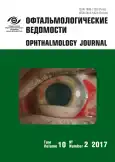The influence of pseudoexfoliative syndrome on corneal morphology based on in vivo confocal microscopy
- Authors: Potemkin V.V.1, Varganova T.S.2, Akopov E.L.1, Ageeva E.V.1
-
Affiliations:
- I.P. Pavlov First St Petersburg State Medical University
- Saint Petersburg State Hospital No 2
- Issue: Vol 10, No 2 (2017)
- Pages: 49-55
- Section: Articles
- URL: https://journals.rcsi.science/ov/article/view/6742
- DOI: https://doi.org/10.17816/OV10249-55
- ID: 6742
Cite item
Abstract
Background: Confocal microscopy is a modern examination method that enables real-time, noninvasive in vivo imaging of the cornea, limb, and conjunctiva.
Aim: To evaluate the main morphological changes observed using confocal microscopy in patients with pseudoexfoliation (PEX) syndrome.
Methods: Overall, 21 patients were examined: 12 with PEX syndrome were enrolled in the examination group and nine patients without PEX in the control group.
Results: In patients with PEX, a decreased cell density in the epithelium and stroma of the cornea as well as a significant increase of hyper-reflective intercellular microdeposits and dendritic cells was observed (p < 0.05).
Full Text
##article.viewOnOriginalSite##About the authors
Vitaly V. Potemkin
I.P. Pavlov First St Petersburg State Medical University
Author for correspondence.
Email: potem@inbox.ru
PhD, assistant professor. Department of Ophthalmology
Russian Federation, Saint PetersburgTatyana S. Varganova
Saint Petersburg State Hospital No 2
Email: varganova.ts@yandex.ru
Ophthalmologist
Russian Federation, Saint PetersburgEvgeniy L. Akopov
I.P. Pavlov First St Petersburg State Medical University
Email: elacop@mail.ru
PhD, assistant professor. Department of Ophthalmology
Russian Federation, Saint PetersburgElena V. Ageeva
I.P. Pavlov First St Petersburg State Medical University
Email: ageeva_elena@inbox.ru
resident. Department of Ophthalmology
Russian Federation, Saint PetersburgReferences
- Потемкин В.В., Агеева Е.В. Состояние глазной поверхности при псевдоэксфолиативном синдроме // Учёные записки СПбГМУ им. акад. И.П. Павлова. – 2016. – Т. 23. – № 1. – С. 47–50. [Potemkin VV, Ageeva EV. Sostojanie glaznoj poverhnosti pri psevdojeksfoliativnom syndrome. Uchjonye zapiski SPbGMU im. akad. I.P. Pavlova. 2016;23(1):47-50 (In Russ.)]
- Kocabeyoğlu S, İrkec M, Orhan M, Mocan M. Evaluation of the Ocular Surface Parameters in Pseudoexfoliation Syndrome and Conjunctivochalasis. Hacettepe University School of Medicine, Department of Ophthalmology. 2012.
- Ritch R, Schlotzer-Schrehardt U. Exfoliation syndrome. Survey of Ophthalmology. 2001;45:265-313.
- Schumacher S, Schlötzer-Schrehardt U, Martus P, et al. Pseudoexfoliation syndrome and aneurysms of the abdominal aorta. Lancet. 2001;357:359-360.
- Schlötzer-Schrehardt U, Naumann GO. Ocular and systemic pseudoexfoliation syndrome. Am J Ophthalm. 2006:921-937.
- Summanen P, Tönjum AM. Exfoliation syndrome. Act Ophthalmol Suppl. 1998;184:107-111
- Schlötzer-Schrehardt U, Koca M, Naumann GO, Volkholz H. Pseudoexfoliation syndrome: ocular manifestation of a systemic disorder. Arch Ophthalmol. 1992;110:1752-1756.
- Zheng Х, Shiraishi A, Okuma Sh, et al. In Vivo Confocal Microscopic Evidence of Keratopathy in Patients with Pseudoexfoliation Syndrome, Investigative Ophthalmology & Visual Science March. 2011;52:1755-1761.
- Naumann GOH, Schlötzer-Schrehardt U. Keratopahty in pseudoexfoliation syndrome as a cause of corneal endothelial decompensation - a clinicopathologic. Ophthalmology. 2000;107:1111-1124.
- Kozobolis VP, Christodoulakis EV, Naoumidi II, et al. Study of conjunctival goblet cell morphology and tear film stability in pseudoexfoliation syndrome. Graefes Arch Clin Exp Ophthalmol. 2004;242:478-483study. Ophthalmology. 2000;107:1111-1124.
- Detorakis ET, Koukoula S, Chrisohoou F, et al. Central corneal mechanical sensitivity in pseudoexfoliation syndrome. Cornea. 2005;24:688-691.
- Ткаченко Н.В., Астахов С.Ю. Диагностические возможности конфокальной микроскопии при исследовании поверхностных структур глазного яблока // Офтальмологические ведомости. – 2009. – Т. 2. – № 1. [Tkachenko NV, Astahov SJu. Diagnosticheskie vozmozhnosti konfokal’noj mikroskopii pri issledovanii poverhnostnyh struktur glaznogo jabloka. Oftal’mologicheskie vedomosti. 2009;2(1). (In Russ.)]
- Oliveira - Soto L, Efron N. Morphology of corneal nerves using confocal microscopy. Cornea. 2001;20(4):374-384.
- Patel S, McLaren J, Hodge D, et al. Normal human keratocyte density and corneal thickness measurement by using confocal microscopy in vivo. Invest Ophthalmol Vis Sci. 2001;42(2)333-339.
- Zhang M, Chen J, Luo L, et al. Altered corneal nerves in aqueous tear deficiency viewed by in vivo confocal microscopy. Cornea. 2005;24:818-824.
- Zhang X, Chen Q, Chen W, et al. Tear dynamics and corneal confocal microscopy of subjects with mild self-reported office dry eye. Ophthalmology. 2011;118:902-907.
- Азнабаев Б.М. Лазерная сканирующая томография глаза: передний и задний сегмент. – М., 2008. [Aznabaev BM. Lazernaja skanirujushhaja tomografija glaza: perednij i zadnij segment. Moscow, 2008. (In Russ.)]
- Jalbert I, Stapleton F, Papas E, et al. In vivo confocal microscopy of the human cornea. Br J Ophthalmol. 2003;87(2):225-236.
- Mastropasqua L, Nubile M. Confocal Microscopy of the Cornea. SLACK Incorporated USA. 2002:122.
- Maurer JK, Jester JV. Use of the vivo confocal microscopy to understand the pathology of accidental ocular irritaition. Toxicol Pathol. 1999;27(1):44-47.
- Masters BR, Thaer A. Real-time scanning slit confocal microscopy of the in vivo human cornea. Applied Optics. 1994;33:695-701.
- Kinard KI, Smith AG, Singleton JR, et al. Chronic migraine is associated with reduced corneal nerve fiber density and symptoms of dry eye. Headache. 2015;55(4):543-549.
- Martone G, Casprini F, Traaversi C, et al. Pseudoexfoliation syndrome: in vivo confocal microscopy analysis. Clin Exp Ophthalmol. 2007;35:582-585.
- Sbeity Z, Palmiero PM, Tello C, et al. Non-contact in vivo confocal scanning laser microscopy in exfoliation syndrome, exfoliation syndrome suspect and normal eyes. Acta Ophthalmol. 2009 Oct 23.
- Tomaszewski BT, Zalewska R, Mariak Z. Evaluation of the Endothelial Cell Density and the Central Corneal Thickness in Pseudoexfoliation Syndrome and Pseudoexfoliation Glaucoma. Journal of Ophthalmology. 2014; 20143. doi: 10.1155/2014/123683. [PubMed]
- Oltulu, Refik, Satirtav,net al. Characteristics of the cornea in patients with pseudoexfoliation syndrome. Arquivos Brasileiros de Oftalmologia. ;78(6) 348-351.
- Demirdögen BC, Ceylan OM, Isikoglu S,Oet al. Evaluation of oxidative stress and paraoxonase phenotypes in pseudoexfoliation syndrome and pseudoexfoliation glaucoma. Clin Lab. 2014;60(1):79-86.
Supplementary files







